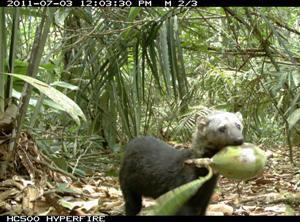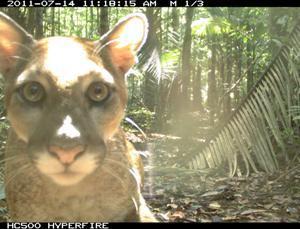Maíra Benchimol de Souza
The aim of the project is to examine the community-wide effects of forest fragmentation on Amazonian forest vertebrates in a major hydroelectric dam.

Tayra (Eira barbara) eating a fruit; also taken by the camera-trap.
The construction of major hydroelectric dams is one of the most important current drivers of habitat loss in lowland Amazonia. At least 662,000ha of pristine forests were inundated by the nine mega-hydroelectric dams constructed to date in the Brazilian Amazon, and 10 additional major dams will be built in this decade. The hydroelectric energy sector promotes widespread erosion of fauna and flora due to high deforestation rates throughout the neighbouring reservoir area and the conversion of large tracts of forest into islands embedded within a unsuitable freshwater matrix. Given escalating investments in hydropower, assessing the potential impact of mega-dams on forest biodiversity persistence has become a high research priority in Amazonian conservation.

Jaguar (Puma concolor) registered by the camera-trap.
The study will take place in a set of central Amazonian land-bridge islands formed after the Balbina Hydroelectric Dam, in the state of Amazonas, Brazil. The Balbina Dam inundated 236,000ha of primary forests, ad created ~3,500 forest islands varying widely in size (<1 to 4,000 ha). Here, we propose to use this fragmented landscape to examine how medium- and large-bodied terrestrial vertebrate populations (mammals, birds and reptiles) respond to drastic post-isolation alteration in landscape structure in the Balbina reservoir, and the synergistic interaction of forest disturbance and forest isolation. Quantitative surveys will be conducted in 30 islands and two mainland forest sites using a combination of six sampling techniques. Patterns of species persistence and community structure will be quantified and related to habitat structure and composition, and different patch and landscape metrics.
This study will document the patterns of local extinction in vertebrate communities within true lacustrine islands and carry out a priority setting exercise for conservation management across all 3,500 Balbina islands using estimates of species richness and composition. Results from this study will also inform pre-construction environmental impact assessments and licensing standards of other Amazonian hydroelectric dam blueprints.